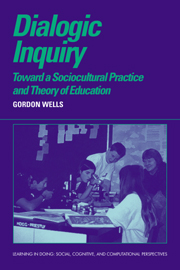Book contents
- Frontmatter
- Contents
- Conventions of Transcription
- Introduction
- Part I Establishing the Theoretical Framework
- Part II Discourse, Learning, and Teaching
- 4 Text, Talk, and Inquiry: Schooling As Semiotic Apprenticeship
- 5 Putting a Tool to Different Uses: A Reevaluation of the IRF Sequence
- 6 From Guessing to Predicting: Progressive Discourse in the Learning and Teaching of Science
- 7 Using the Tool-kit of Discourse in the Activity of Learning and Teaching
- 8 Making Meaning with Text: A Genetic Approach to the Mediating Role of Writing
- Part III Learning and Teaching in the zpd
- Appendix I A Social Constructivist Model of Learning and Teaching
- Appendix II Categories for the Analysis of Discourse
- References
- Index of Authors
- Index of Subjects
- Title in the series
7 - Using the Tool-kit of Discourse in the Activity of Learning and Teaching
Published online by Cambridge University Press: 09 November 2009
- Frontmatter
- Contents
- Conventions of Transcription
- Introduction
- Part I Establishing the Theoretical Framework
- Part II Discourse, Learning, and Teaching
- 4 Text, Talk, and Inquiry: Schooling As Semiotic Apprenticeship
- 5 Putting a Tool to Different Uses: A Reevaluation of the IRF Sequence
- 6 From Guessing to Predicting: Progressive Discourse in the Learning and Teaching of Science
- 7 Using the Tool-kit of Discourse in the Activity of Learning and Teaching
- 8 Making Meaning with Text: A Genetic Approach to the Mediating Role of Writing
- Part III Learning and Teaching in the zpd
- Appendix I A Social Constructivist Model of Learning and Teaching
- Appendix II Categories for the Analysis of Discourse
- References
- Index of Authors
- Index of Subjects
- Title in the series
Summary
Schooling, as a form of socialization through culture transmission, has been part of our culture for so long that we take for granted its encapsulated nature and its almost total dependence on oral and written discourse. Add to this an uncritical acceptance by many educators of the conduit metaphor of communication, in which utterances carry thoughts as trucks carry coal (Reddy, 1979), and it is perhaps not surprising that many attempts to understand the role of language in learning and teaching have treated the verbal component of classroom events as self-sufficient, and analyzed the talk as if, like a window, it gave direct access to what was going on in the learners' minds (Edwards, 1993).
But what if this view of learning as the increasing ability to send and receive verbal messages containing more, and more complex and abstract, information about non-present objects and events is an aberration – a byproduct of the form that schooling has happened to take in Western culture? In many other cultures, learning is not treated as a separate activity; and, even in our own culture, this is rarely the case outside the classroom. Instead, it is recognized to be a concomitant of engagement in joint activity with help from other people. Nor, outside the classroom, is learning conceived of as a purely verbal affair. For simply being able to talk or write about a practice is no substitute for being able to engage in it effectively.
- Type
- Chapter
- Information
- Dialogic InquiryTowards a Socio-cultural Practice and Theory of Education, pp. 231 - 266Publisher: Cambridge University PressPrint publication year: 1999



